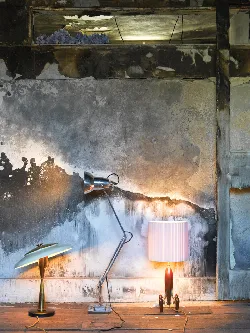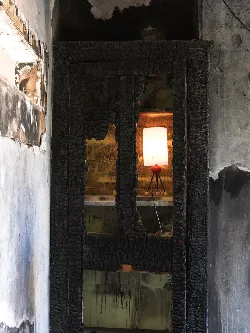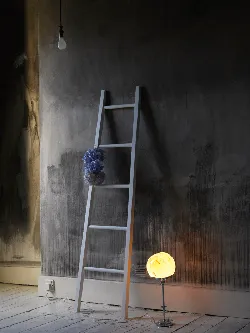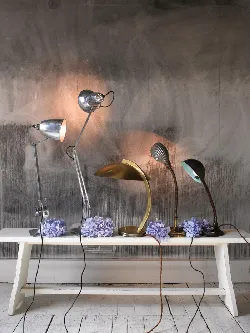With current tastes preferring all things authentic and original, interior designers and stylists are first in the queue to snap up what are considered to be classic, vintage table lamps – produced from the 1930s, right through to the 1970s. Although the work of big names, such as Sixties’ design wunderkind Verner Panton (1926-98), can cost in excess of £1,000, design connoisseurs view this as money well spent. Happily, there are also plenty of equally chic lamps by lesser-known names out there – each with that irresistible combination of good value and good looks, which makes them among the most tempting of retro purchases.

So when did we fall in love with the humble table lamp? Well, take a look around your home and you will, no doubt, have a few scattered around – these days they're as much of an everyday item as a sofa or dining table, but it hasn’t always been so. Although electricity arrived in suburbia for the first time in 1905, it wasn’t until the 1920s that electric lamps found a popular place in our homes, replacing oil lamps and gaslights. With the arrival of Art Deco and Modernism, lighting designers and manufacturers explored new design possibilities and discovered that a table lamp could be an engineering masterpiece and a work of art combined.
Revolutionary design
England’s ‘light bulb’ moment came in 1932. Inspired by the form of the human arm, and after experimenting with different springs, George Carwardine invented a light that was functional and stylish at the same time – the revolutionary anglepoise lamp. He refined his first design, the ‘Anglepoise 1209’, and two years later, in 1934, Herbert Terry & Sons manufactured Carwardine’s new ‘1227’. It’s changed little since then and, in its 21st-century guise (the ‘Type 3’), is still produced today.
Its only real rival was the ‘BestLite’, a swan-necked, height-adjustable lamp, set on a curving metal arm. It was designed by Robert Dudley Best in 1930, and eventually endeared itself to the nation after appearing in photos of Winston Churchill’s desk in his air-raid shelter during World War Two. Chris Gray of Twentieth Century Interiors is a fan: ‘The BestLite is perfect for someone reading while sat in an armchair – it has a lovely, loose diffusion of light that can be angled over just the right area.’ A Thirties’ BestLite in good condition will now cost in excess of £300.

Global style
Over the last 70 years, the art of the table lamp has been a truly international affair. Influential designs were conceived and produced all over Europe and in Scandinavia. In Denmark, in 1971, Louis Poulsen manufactured Verner Panton’s design, the ‘Panthella’, an all-white table lamp with acrylic hemispherical shade, which today is worth £200-£300. During the late 1930s, the German firm Kaiser Idell produced Christian Dell’s ‘6631 Luxus’ lamp (now worth in the region of £300-£400), while the classic ‘Saucer’ (with UFO-shaped shade), designed by Louis Kalff for Philips in 1955, was flying off the shelves in Holland. You can expect to pay in the region of £200-£250 for an original example now.
Indeed, the space race exerted a huge influence on designers from the 1950s right through to the 1970s, and the Sputnik-style lights from this period are outstandingly decorative. For a lamp that makes a powerful design statement, redolent of mid-century style, track down one of the British, distinctively 1960s’ rocket lamps. The fibreglass bodies of these rockets, set on slender teak legs, give out a gentle, otherworldly glow (expect to pay £70-£100).
One of the most distinctive and desirable lamps is the ‘Taccia’, designed in 1962 by Achille and Pier Giacomo Castiglioni (the brothers who brought us the ‘Arco’ floor lamp), and produced by Italian manufacturer Flos. It looks like an upturned floodlight: a stocky, fluted, anodised-aluminium column, supporting a single, oversized glass diffuser, which can be rotated to direct the light. Though small in scale, the ‘Taccia’ looks oddly monumental. The shape is utterly simple and completely satisfying.

Original and best
Still in production, a contemporary ‘Taccia’ can be found for around £1,000 in upmarket interiors stores. But the real Sixties’ deal, with hand-blown glass diffuser, can be bought from a vintage lighting specialist for approximately £200 more. Why should we spend a few pounds extra for an original? ‘Vintage lights hold their value,’ explains Jeff Salmon of Decoratum, in London. ‘Everyone wants a first edition, don’t they? The earliest versions were made in a limited quantity and were of the best quality, so if you want to sell them at some point in the future, you’ll be sure to get your money back. If you buy one of the new licensed examples, the resale value will be a fraction of what you paid. That said, I don’t generally advise buying as an investment – although, when you do, it inevitably turns out to be a wise purchase,’ he adds, with a knowing smile.
The one thing all these international lamps have in common is their clever combination of form and function, so it’s no surprise that there is such a strong fan-base among 21st-century buyers. Interior designer Joanna Wood has a particular passion for mid-century task lights: ‘I love using vintage lamps in my rooms,’ she says. ‘I’m inspired by the practicality and elegance of examples that have proven style longevity, but also work well in a modern setting.’

Get the look for less
When it comes to table lamps, there’s no need to opt for the work of famous names to get great design. The best manufacturers turned out top quality, ultra-chic lighting created by anonymous in-house designers. Specialist dealer Michael Marks of 20th Century Marks says that buying these more obscure gems is the key to getting value. ‘My advice is don’t follow the masses,’ he says. ‘Look beyond the famous designer names and you’ll get something just as stylish for less. As long as you buy the work of a respected manufacturer – for instance Arteluce or Artemide – the quality will be good.’ Michael sells 1960s’ desk lamps made by Fase, a renowned Spanish factory, for around £150, while various 1970s’ models by unnamed designers at Italian manufacturer Artemide cost around £100 a piece. Other sought-after makers include Hadrill & Horstmann, a Surrey firm whose beautifully engineered 1950s’ counterweight lamps are currently valued at £300-£350. Whatever you buy, Chris Gray has some sound advice: ‘When you buy a lamp, you need to understand how it lights the space. Make sure you see it switched on, and see how it diffuses the light, before you part with any cash.’
So, armed with this insider knowledge, and once you’ve got your eye in and are able to recognise some of the more desirable shapes and makers, head down to your local car boot sale. Who knows what finds you might light upon?
Find out more
Buy
020 8995 4166
07957 300848
020 7359 4281
07958 519157
020 7723 6066
020 7724 4802
07917 871337
01474 872460
Read
20th-Century Design Buyer’s Guide by Paul Rennie (Miller’s, £19.99)
View
28 Shad Thames, London. 020 7403 6933
Safety first
A few necessary checks Every vintage lamp should be overhauled by a professional electrician before you plug it in and switch it on. Specialist dealers will often sell reconditioned lights; however, if you pick yours up at a car boot sale or from an online auction, factor in a cost of around £25 for a professional check-up. This will usually involve the replacement of the original bulb holder for a new heat-resistant version. It is also possible to change the location of the on-off control.
STYLING: Jo Barnes
PHOTOGRAPHS: Chris Tubs